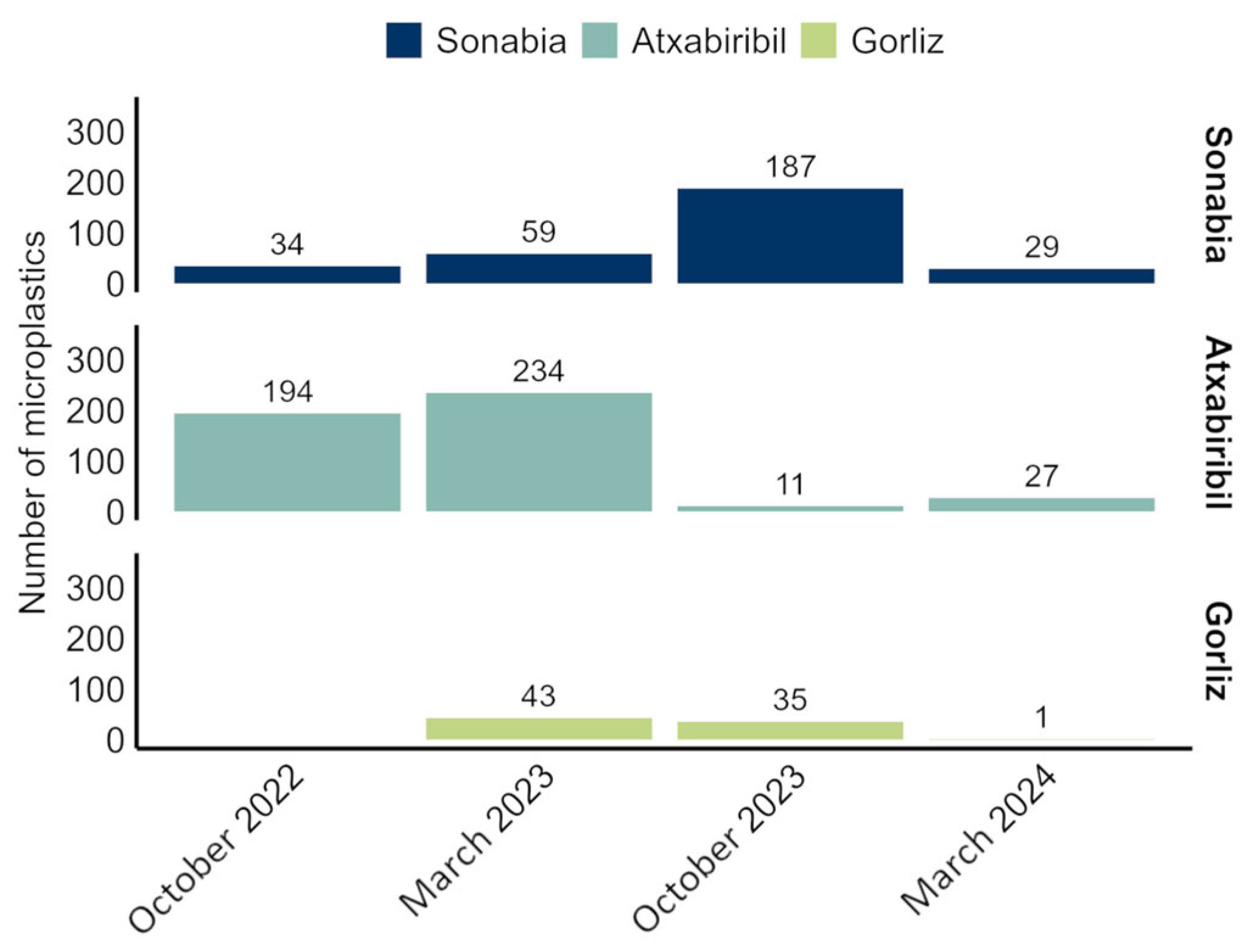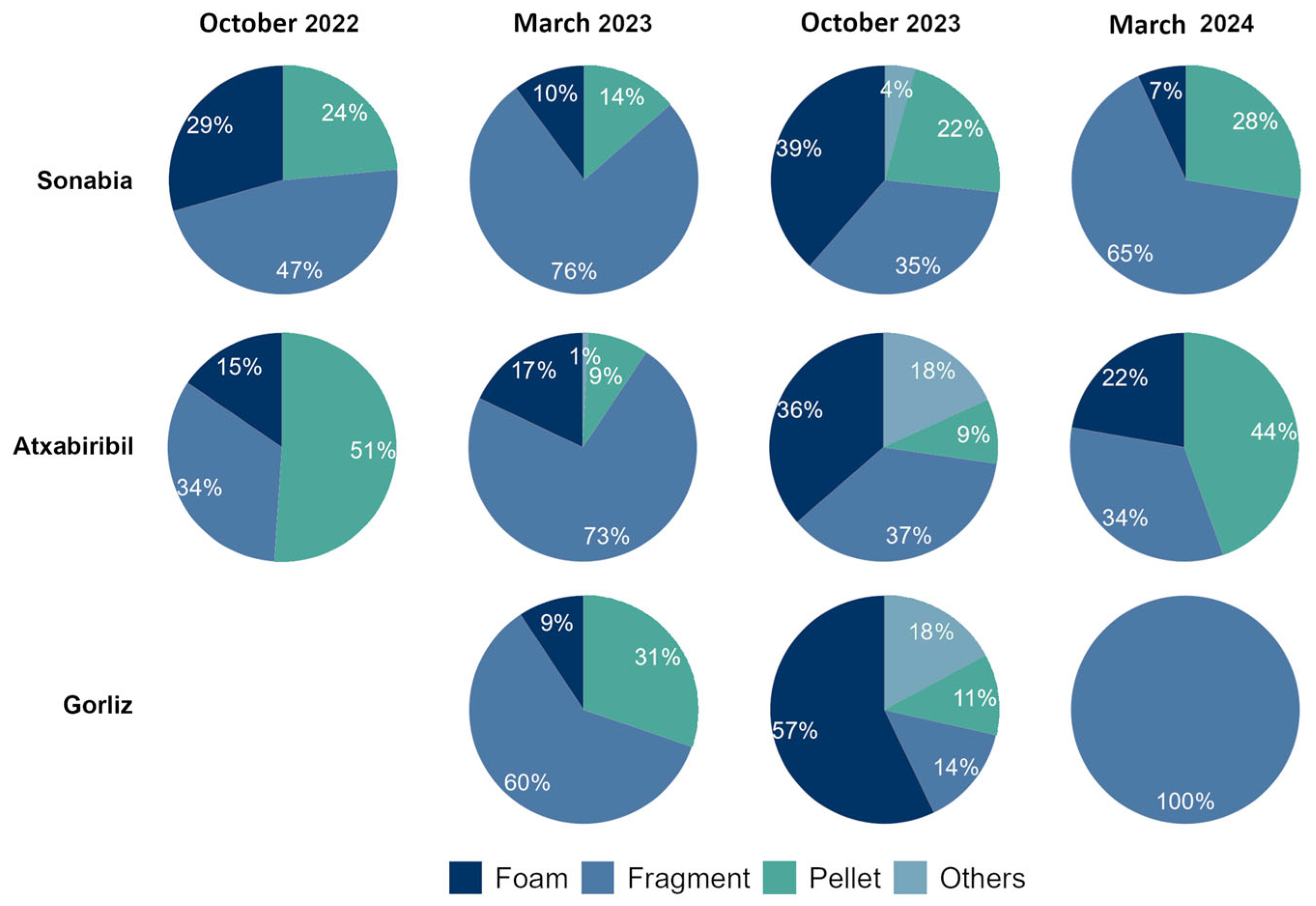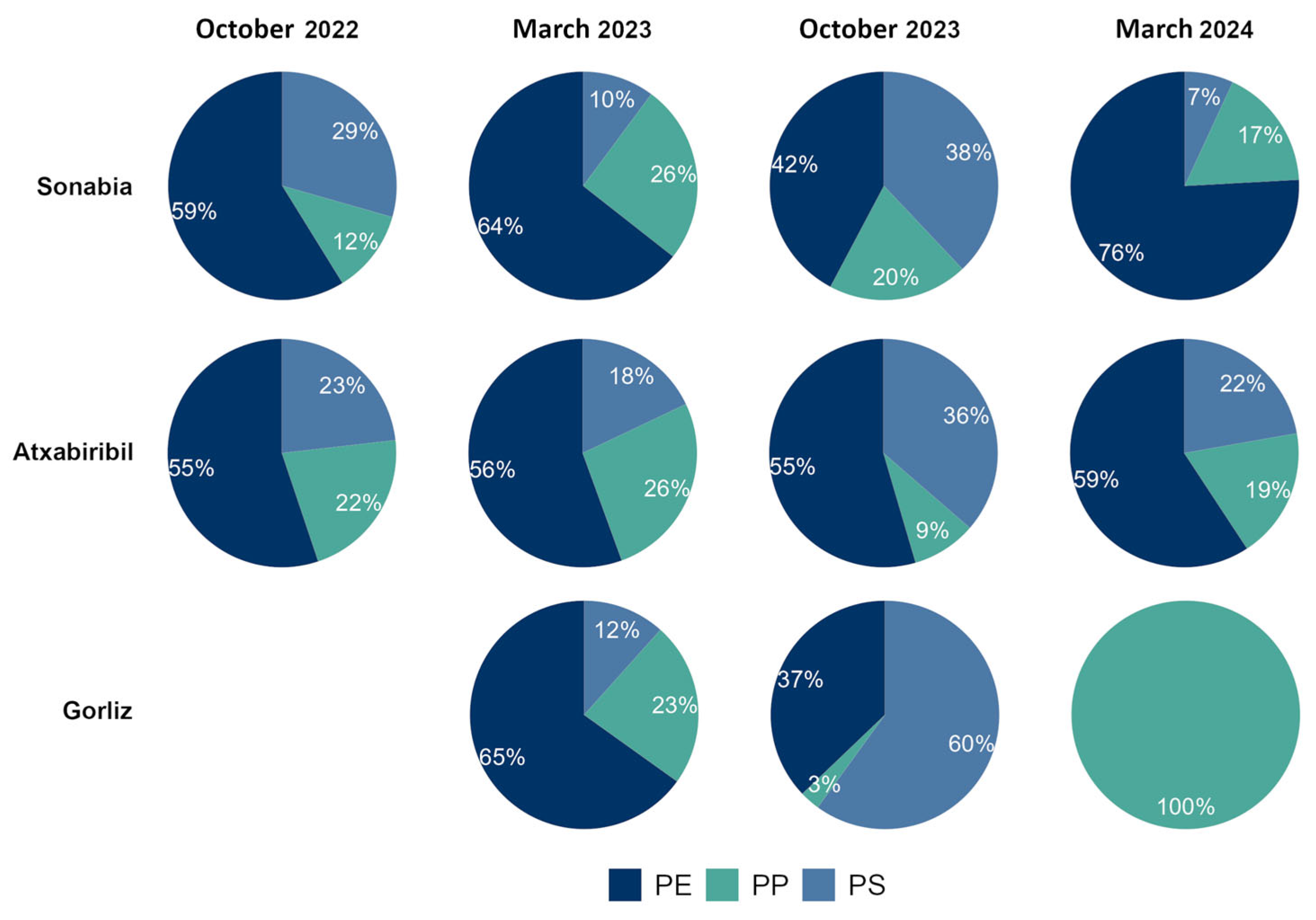Chemical and Physical Characterisation of Microplastics Present on Beaches of the Cantabrian Coast, Bay of Biscay (Spain)
Abstract
1. Introduction
2. Materials and Methods
2.1. Study Area
2.2. Sample Collection and Processing
3. Results
3.1. Presence of Microplastics on Beaches and Its Evolution over Time
3.2. Chemical and Morphological Characterisation of Microplastics
4. Discussion
4.1. Presence of Microplastics on Beaches and Its Evolution over Time
4.2. Chemical and Morphological Characterisation of Microplastics
5. Conclusions
Supplementary Materials
Author Contributions
Funding
Data Availability Statement
Acknowledgments
Conflicts of Interest
Abbreviations
| ATR | Attenuated Total Reflectance |
| BoB | Bay of Biscay |
| CEDEX | Centre for Public Work Studies and Experimentation |
| FTIR | Fourier-Transform InfraRed (FTIR) Spectroscopy |
| FTIR-ATR | Fourier-Transform InfraRed Spectroscopy combined with Attenuated Total Reflectance |
| PE | Polyethylene |
| PP | Polypropylene |
| PS | Polystyrene |
| WWTP | Wastewater Treatment Plant |
References
- Bellou, N.; Gambardella, C.; Karantzalos, K.; Monteiro, J.G.; Canning-Clode, J.; Kemna, S.; Arrieta-Giron, C.A.; Lemmen, C. Global Assessment of Innovative Solutions to Tackle Marine Litter. Nat. Sustain. 2021, 4, 516–524. [Google Scholar] [CrossRef]
- Borrelle, S.B.; Ringma, J.; Law, K.L.; Monnahan, C.C.; Lebreton, L.; McGivern, A.; Murphy, E.; Jambeck, J.; Leonard, G.H.; Hilleary, M.A.; et al. Predicted Growth in Plastic Waste Exceeds Efforts to Mitigate Plastic Pollution. Science 2020, 369, 1515–1518. [Google Scholar] [CrossRef] [PubMed]
- Chen, Y.; Awasthi, A.K.; Wei, F.; Tan, Q.; Li, J. Single-Use Plastics: Production, Usage, Disposal, and Adverse Impacts. Sci. Total Environ. 2021, 752, 141772. [Google Scholar] [CrossRef] [PubMed]
- PlasticOceans (Plastic Oceans International). The Facts “More than 10 Million Tons of Plastic Are Dumped in Our Oceans Every Year”. Available online: https://plasticoceans.org/the-facts/ (accessed on 15 September 2025).
- Walker, T.R.; Fequet, L. Current Trends of Unsustainable Plastic Production and Micro(Nano)Plastic Pollution. TrAC Trends Anal. Chem. 2023, 160, 116984. [Google Scholar] [CrossRef]
- Soursou, V.; Campo, J.; Picó, Y. Spatio-Temporal Variation and Ecological Risk Assessment of Microplastics along the Touristic Beaches of a Mediterranean Coast Transect (Valencia Province, East Spain). J. Environ. Manag. 2024, 354, 120315. [Google Scholar] [CrossRef]
- An, L.; Liu, Q.; Deng, Y.; Wu, W.; Gao, Y.; Ling, W. Sources of Microplastic in the Environment. In Microplastics in Terrestrial Environments; He, D., Luo, Y., Eds.; The Handbook of Environmental Chemistry; Springer International Publishing: Cham, Switzerland, 2020; Volume 95, pp. 143–159. ISBN 978-3-030-56270-0. [Google Scholar]
- Klein, M.; Fischer, E.K. Microplastic Abundance in Atmospheric Deposition within the Metropolitan Area of Hamburg, Germany. Sci. Total Environ. 2019, 685, 96–103. [Google Scholar] [CrossRef]
- Liu, K.; Wang, X.; Fang, T.; Xu, P.; Zhu, L.; Li, D. Source and Potential Risk Assessment of Suspended Atmospheric Microplastics in Shanghai. Sci. Total Environ. 2019, 675, 462–471. [Google Scholar] [CrossRef]
- Liu, M.; Lu, S.; Song, Y.; Lei, L.; Hu, J.; Lv, W.; Zhou, W.; Cao, C.; Shi, H.; Yang, X.; et al. Microplastic and Mesoplastic Pollution in Farmland Soils in Suburbs of Shanghai, China. Environ. Pollut. 2018, 242, 855–862. [Google Scholar] [CrossRef]
- Möller, J.N.; Löder, M.G.J.; Laforsch, C. Finding Microplastics in Soils: A Review of Analytical Methods. Environ. Sci. Technol. 2020, 54, 2078–2090. [Google Scholar] [CrossRef]
- Desforges, J.-P.W.; Galbraith, M.; Dangerfield, N.; Ross, P.S. Widespread Distribution of Microplastics in Subsurface Seawater in the NE Pacific Ocean. Mar. Pollut. Bull. 2014, 79, 94–99. [Google Scholar] [CrossRef]
- Álvarez-Hernández, C.; Cairós, C.; López-Darias, J.; Mazzetti, E.; Hernández-Sánchez, C.; González-Sálamo, J.; Hernández-Borges, J. Microplastic Debris in Beaches of Tenerife (Canary Islands, Spain). Mar. Pollut. Bull. 2019, 146, 26–32. [Google Scholar] [CrossRef]
- Maupas, T.; Gomez-Laserna, O.; Uribe-Martinez, U.; Salazar, D.; Grassl, B.; De Diego, A. Raman Imaging Spectroscopic Solutions for Microplastics Advanced Analysis: Insights from Choqueyapu River Basin (La Paz, Bolivia). Microchem. J. 2024, 204, 110988. [Google Scholar] [CrossRef]
- Cole, M.; Lindeque, P.; Fileman, E.; Halsband, C.; Goodhead, R.; Moger, J.; Galloway, T.S. Microplastic Ingestion by Zooplankton. Environ. Sci. Technol. 2013, 47, 6646–6655. [Google Scholar] [CrossRef] [PubMed]
- Neves, D.; Sobral, P.; Ferreira, J.L.; Pereira, T. Ingestion of Microplastics by Commercial Fish off the Portuguese Coast. Mar. Pollut. Bull. 2015, 101, 119–126. [Google Scholar] [CrossRef] [PubMed]
- Bessa, F.; Barría, P.; Neto, J.M.; Frias, J.P.G.L.; Otero, V.; Sobral, P.; Marques, J.C. Occurrence of Microplastics in Commercial Fish from a Natural Estuarine Environment. Mar. Pollut. Bull. 2018, 128, 575–584. [Google Scholar] [CrossRef] [PubMed]
- Besseling, E.; Foekema, E.M.; Van Franeker, J.A.; Leopold, M.F.; Kühn, S.; Bravo Rebolledo, E.L.; Heße, E.; Mielke, L.; IJzer, J.; Kamminga, P.; et al. Microplastic in a Macro Filter Feeder: Humpback Whale Megaptera Novaeangliae. Mar. Pollut. Bull. 2015, 95, 248–252. [Google Scholar] [CrossRef]
- Nihart, A.J.; Garcia, M.A.; El Hayek, E.; Liu, R.; Olewine, M.; Kingston, J.D.; Castillo, E.F.; Gullapalli, R.R.; Howard, T.; Bleske, B.; et al. Bioaccumulation of Microplastics in Decedent Human Brains. Nat. Med. 2025, 31, 1114–1119. [Google Scholar] [CrossRef]
- Zhu, L.; Kang, Y.; Ma, M.; Wu, Z.; Zhang, L.; Hu, R.; Xu, Q.; Zhu, J.; Gu, X.; An, L. Tissue Accumulation of Microplastics and Potential Health Risks in Human. Sci. Total Environ. 2024, 915, 170004. [Google Scholar] [CrossRef]
- Leistenschneider, C.; Burkhardt-Holm, P.; Mani, T.; Primpke, S.; Taubner, H.; Gerdts, G. Microplastics in the Weddell Sea (Antarctica): A Forensic Approach for Discrimination between Environmental and Vessel-Induced Microplastics. Environ. Sci. Technol. 2021, 55, 15900–15911. [Google Scholar] [CrossRef]
- Kanhai, L.D.K.; Gårdfeldt, K.; Lyashevska, O.; Hassellöv, M.; Thompson, R.C.; O’Connor, I. Microplastics in Sub-Surface Waters of the Arctic Central Basin. Mar. Pollut. Bull. 2018, 130, 8–18. [Google Scholar] [CrossRef]
- Munari, C.; Infantini, V.; Scoponi, M.; Rastelli, E.; Corinaldesi, C.; Mistri, M. Microplastics in the Sediments of Terra Nova Bay (Ross Sea, Antarctica). Mar. Pollut. Bull. 2017, 122, 161–165. [Google Scholar] [CrossRef]
- Rochman, C.M.; Hoh, E.; Kurobe, T.; Teh, S.J. Ingested Plastic Transfers Hazardous Chemicals to Fish and Induces Hepatic Stress. Sci. Rep. 2013, 3, 3263. [Google Scholar] [CrossRef]
- Antunes, J.C.; Frias, J.G.L.; Micaelo, A.C.; Sobral, P. Resin Pellets from Beaches of the Portuguese Coast and Adsorbed Persistent Organic Pollutants. Estuar. Coast. Shelf Sci. 2013, 130, 62–69. [Google Scholar] [CrossRef]
- Santos-Echeandía, J.; Rivera-Hernández, J.R.; Rodrigues, J.P.; Moltó, V. Interaction of Mercury with Beached Plastics with Special Attention to Zonation, Degradation Status and Polymer Type. Mar. Chem. 2020, 222, 103788. [Google Scholar] [CrossRef]
- Luijendijk, A.; Hagenaars, G.; Ranasinghe, R.; Baart, F.; Donchyts, G.; Aarninkhof, S. The State of the World’s Beaches. Sci. Rep. 2018, 8, 6641. [Google Scholar] [CrossRef] [PubMed]
- Simantiris, N.; Vardaki, M.Z. A Systematic Review and Scientometrics Analysis on Microplastic Pollution on Coastal Beaches around the Globe. Cont. Shelf Res. 2025, 286, 105424. [Google Scholar] [CrossRef]
- Martellini, T.; Guerranti, C.; Scopetani, C.; Ugolini, A.; Chelazzi, D.; Cincinelli, A. A Snapshot of Microplastics in the Coastal Areas of the Mediterranean Sea. TrAC Trends Anal. Chem. 2018, 109, 173–179. [Google Scholar] [CrossRef]
- Pereiro, D.; Souto, C.; Gago, J. Dynamics of Floating Marine Debris in the Northern Iberian Waters: A Model Approach. J. Sea Res. 2019, 144, 57–66. [Google Scholar] [CrossRef]
- Rodríguez-Díaz, L.; Gómez-Gesteira, J.L.; Costoya, X.; Gómez-Gesteira, M.; Gago, J. The Bay of Biscay as a Trapping Zone for Exogenous Plastics of Different Sizes. J. Sea Res. 2020, 163, 101929. [Google Scholar] [CrossRef]
- Mendoza, A.; Osa, J.L.; Basurko, O.C.; Rubio, A.; Santos, M.; Gago, J.; Galgani, F.; Peña-Rodriguez, C. Microplastics in the Bay of Biscay: An Overview. Mar. Pollut. Bull. 2020, 153, 110996. [Google Scholar] [CrossRef]
- CEDEX. Programa de Seguimiento de Micropartículas en Playas (BM-6). 2022. Available online: https://www.miteco.gob.es/content/dam/miteco/es/costas/temas/proteccion-medio-marino/23_422_5_007_Programa_Seguimiento_BM6_2022_MEMORIA+ANEJOS.pdf (accessed on 25 September 2025).
- Phuong, N.N.; Poirier, L.; Lagarde, F.; Kamari, A.; Zalouk-Vergnoux, A. Microplastic Abundance and Characteristics in French Atlantic Coastal Sediments Using a New Extraction Method. Environ. Pollut. 2018, 243, 228–237. [Google Scholar] [CrossRef]
- Irabien, M.J.; Cearreta, A.; Gómez-Arozamena, J.; Serrano, H.; Sanchez-Cabeza, J.-A.; Ruiz-Fernández, A.C. Geological Record of Extreme Floods and Anthropogenic Impacts on an Industrialised Bay: The Inner Abra of Bilbao (Northern Spain). Sci. Total Environ. 2019, 696, 133946. [Google Scholar] [CrossRef]
- Gobierno Vasco. Departamento de Salud. Arranca la Temporada de Baño en Euskadi con una Calidad Excelente en la Mayoría de Nuestras Zonas de Baño y Playas. Gobierno Vasco. 2024. Available online: https://www.euskadi.eus/noticia/2024/arranca-temporada-bano-euskadi-calidad-excelente-mayoria-nuestras-zonas-bano-y-playas/web01-a2salpol/es/ (accessed on 27 October 2025).
- Agencia Vasca de la Red de Aguas. Informe Sobre los Perfiles de Baño en las Zonas Oficiales: Otro Informe Playa Arrietara-Atxabiribil. 2023. Available online: https://www.uragentzia.euskadi.eus/informacion-sobre-los-perfiles-de-bano-en-las-zonas-oficiales/webura00-contents/es/s/contenidos/informacion/perfiles_bano/es_def/adjuntos/2023_07_Arriatera-Atxabiribil.pdf (accessed on 16 September 2025).
- Agencia Vasca de la Red de Aguas. Informe Sobre los Perfiles de Baño en las Zonas Oficiales: Otro Informe Playa Gorliz. 2023. Available online: https://www.uragentzia.euskadi.eus/contenidos/informacion/perfiles_bano/es_def/adjuntos/2023_10_Gorliz.pdf (accessed on 16 September 2025).
- Elorza, J.; Higuera-Ruiz, R. Morfologías escalonadas de erosión eólica y disolución química sobre las calizas Urgonianas en la playa de Valdearenas (Sonabia, Cantabria). Rev. Soc. Geol. Esp. 2015, 28, 25–39. [Google Scholar]
- European Commission, Joint Research Centre, Institute for Environment and Sustainability. MSFD Technical Subgroup on Marine Litter. In Guidance on Monitoring of Marine Litter in European Seas; Publications Office: Luxembourg, 2013. [Google Scholar]
- Expósito, N.; Sierra, J.; Martí, E.; Folch, J.; Ratola, N.; Schuhmacher, M.; Rovira, J. Detection of Microplastic Hotspots in Beach Sand for National Surveys Using Fluorescence Microscopy and Infrared Spectroscopy: Case Study on the Catalan Coast. Mar. Pollut. Bull. 2025, 214, 117761. [Google Scholar] [CrossRef] [PubMed]
- Mendoza, A. Evaluación de la Presencia de Microplásticos en el Litoral del Sudeste del Golfo de Bizkaia. In Microplásticos en el Litoral del Sudeste del Golfo de Bizkaia. Caracterización, Focos y Estrategias de Control y Prevención. Ph.D. Thesis, University of the Basque Country (EHU), Gipuzkoa, Spain, 2022. Available online: http://hdl.handle.net/10810/59254 (accessed on 6 November 2025).
- Key, S.; Ryan, P.G.; Gabbott, S.E.; Allen, J.; Abbott, A.P. Influence of Colourants on Environmental Degradation of Plastic Litter. Environ. Pollut. 2024, 347, 123701. [Google Scholar] [CrossRef] [PubMed]
- Cocozza, P.; Serranti, S.; Setini, A.; Cucuzza, P.; Bonifazi, G. Monitoring of Contamination by Microplastics on Sandy Beaches at Vulcano Island (Sicily, Italy) by Hyperspectral Imaging. Enviro. Sci. Pollut. Res. 2024, 32, 16898–16911. [Google Scholar] [CrossRef] [PubMed]
- Khoironi, A.; Hadiyanto, H.; Anggoro, S.; Sudarno, S. Evaluation of Polypropylene Plastic Degradation and Microplastic Identification in Sediments at Tambak Lorok Coastal Area, Semarang, Indonesia. Mar. Pollut. Bull. 2020, 151, 110868. [Google Scholar] [CrossRef]
- Pfohl, P.; Wagner, M.; Meyer, L.; Domercq, P.; Praetorius, A.; Hüffer, T.; Hofmann, T.; Wohlleben, W. Environmental Degradation of Microplastics: How to Measure Fragmentation Rates to Secondary Micro- and Nanoplastic Fragments and Dissociation into Dissolved Organics. Environ. Sci. Technol. 2022, 56, 11323–11334. [Google Scholar] [CrossRef]
- Ouri, A.; Guesmi, M.; Jlalia, I.; Grassl, B.; Abderrazak, H.; Souissi, R. Assessing Microplastic Presence and Distribution in Sandy Beaches: A Case Study of the Gulf of Tunis Coastline. Euro-Mediterr. J. Environ. Integr. 2025, 10, 437–450. [Google Scholar] [CrossRef]
- Lee, S.; Tsuruda, Y.; Honda, M.; Mukai, K.; Hirasawa, T.; Wijaya, D.C.; Takai, Y.; Simasaki, Y.; Oshima, Y. Fragmentation of Expanded Polystyrene to Microplastics by Wharf Roach Ligia Spp. Mar. Pollut. Bull. 2025, 214, 117769. [Google Scholar] [CrossRef]
- Ministerio para la Transición Ecológica y el Reto Demográfico (MITECO). Registro EMAS—País Vasco. Gobierno de España. Available online: https://www.miteco.gob.es/es/calidad-y-evaluacion-ambiental/temas/sistema-comunitario-de-ecogestion-y-ecoauditoria-emas/registro-y-promocion/pais_vasco.html (accessed on 27 October 2025).







| Beach | Geographical Coordinates | Surrounding Area | Tourist Facilities | River Influence | Exposed to Wastewater Discharge | Harbour Activities | Regular Cleaning |
|---|---|---|---|---|---|---|---|
| Sonabia | 43°24′43″ N 3°20′05″ W | Natural | Low | No | No | No | No |
| Atxabiribil | 43°24′43″ N 3°20′05″ W | Semi urban | Medium | No | No | No | Yes |
| Gorliz | 43°24′57″ N 2°56′40″ W | Urban | High | Yes | Yes | Yes | Yes |
Disclaimer/Publisher’s Note: The statements, opinions and data contained in all publications are solely those of the individual author(s) and contributor(s) and not of MDPI and/or the editor(s). MDPI and/or the editor(s) disclaim responsibility for any injury to people or property resulting from any ideas, methods, instructions or products referred to in the content. |
© 2025 by the authors. Licensee MDPI, Basel, Switzerland. This article is an open access article distributed under the terms and conditions of the Creative Commons Attribution (CC BY) license (https://creativecommons.org/licenses/by/4.0/).
Share and Cite
Uribe-Martinez, U.; Maupas, T.; Lapazaran, A.; Rodriguez, R.; Gómez-Laserna, O.; Olazabal, M.Á.; Ayala-Cabrera, J.F.; de Diego, A. Chemical and Physical Characterisation of Microplastics Present on Beaches of the Cantabrian Coast, Bay of Biscay (Spain). Hydrology 2025, 12, 298. https://doi.org/10.3390/hydrology12110298
Uribe-Martinez U, Maupas T, Lapazaran A, Rodriguez R, Gómez-Laserna O, Olazabal MÁ, Ayala-Cabrera JF, de Diego A. Chemical and Physical Characterisation of Microplastics Present on Beaches of the Cantabrian Coast, Bay of Biscay (Spain). Hydrology. 2025; 12(11):298. https://doi.org/10.3390/hydrology12110298
Chicago/Turabian StyleUribe-Martinez, Uxue, Thomas Maupas, Aritz Lapazaran, Ruben Rodriguez, Olivia Gómez-Laserna, María Ángeles Olazabal, Juan F. Ayala-Cabrera, and Alberto de Diego. 2025. "Chemical and Physical Characterisation of Microplastics Present on Beaches of the Cantabrian Coast, Bay of Biscay (Spain)" Hydrology 12, no. 11: 298. https://doi.org/10.3390/hydrology12110298
APA StyleUribe-Martinez, U., Maupas, T., Lapazaran, A., Rodriguez, R., Gómez-Laserna, O., Olazabal, M. Á., Ayala-Cabrera, J. F., & de Diego, A. (2025). Chemical and Physical Characterisation of Microplastics Present on Beaches of the Cantabrian Coast, Bay of Biscay (Spain). Hydrology, 12(11), 298. https://doi.org/10.3390/hydrology12110298







